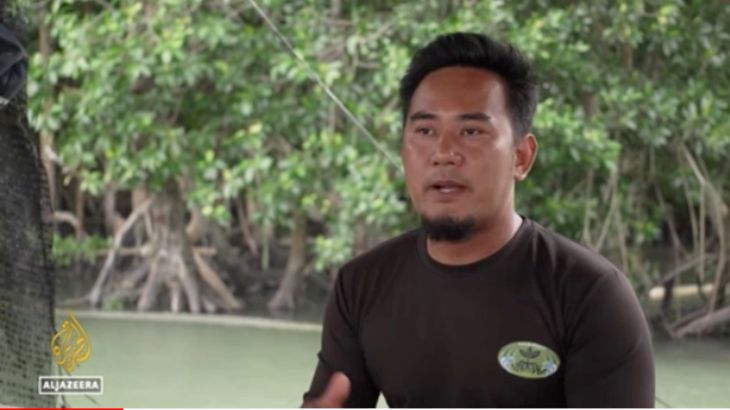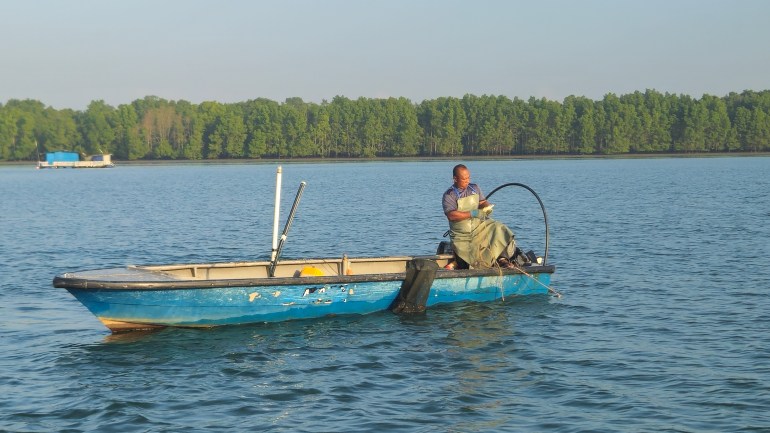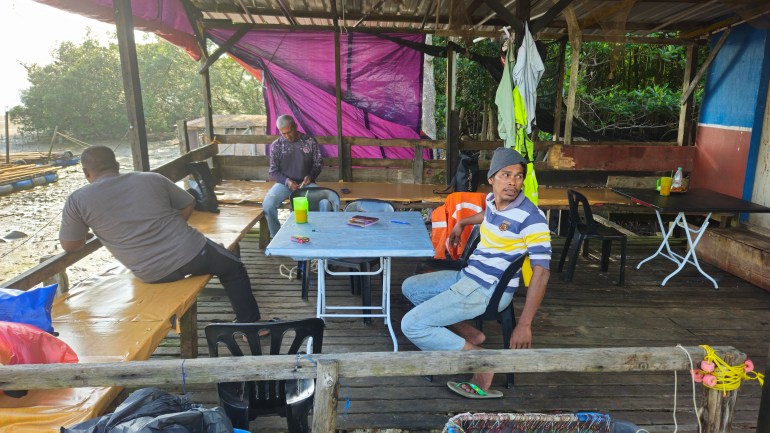Climate change pushes Malaysia’s coastal fishermen away from the sea
Going to sea in small boats has become increasingly risky as the weather becomes unpredictable.

Gelang Patah, Malaysia – On an overcast morning six years ago, Mohammad Ridhwan Mohd Yazid was on his way back to Malaysia’s southern Johor coast when his small fishing boat was caught in a sudden storm.
In a matter of minutes, the calm southerly March winds transformed into gales whipping up high seas that slammed into his boat, knocking both him and the day’s catch into the air.
Keep reading
list of 4 itemsMalaysia could renew search for MH370 plane 10 years after it vanished
Malaysia’s top court rules some Islamic laws in Kelantan unconstitutional
Malaysia says it recovered $5m of stolen 1MDB assets over last 13 months
Alone and about a kilometre (about half a mile) from Singapore’s northwestern shore, Ridhwan landed back on the boat near its engine and turned quickly for land.
“I didn’t care that I lost half of what I caught that day. I just wanted to go home,” the 30-year-old told Al Jazeera in an interview at the coastal jetty in Pendas, a fishing village in Malaysia’s southern state of Johor.
Ridhwan’s tale is not an isolated one, but shared by many traditional Malaysian fishermen who have found themselves increasingly affected by the climate crisis, which is changing weather patterns that have long governed when and where they can fish.
Such fishermen are estimated to make up about 65 percent of Malaysia’s total fishing community, and are small-scale operators from seaside or river communities and ply waters close to shore or along the river for fish, clams, crabs and other marine animals to meet local demand.
They typically use single-engine boats about seven metres (23 feet) long, casting their nets in an area up to five nautical miles (9.3km) from the shore along the country’s more than 4,600km (2,858 miles) of coastline.

But erratic weather, warming seas and declining fish stocks caused by climate change are slowly pushing them away from the seas they and generations before them once depended on.
“In the past, we didn’t have to go far to get a good catch. We could just go near the shore,” said Mohd Hafiza Abu Talib.
Now, he said, winds could shift direction without warning, treacherous for those who usually work alone or fish at night.
“The winds can suddenly change and bring us somewhere else. It’s even worse when we fish in the dark, and we don’t have GPS,” the man in his late 40s added.
Warming waters
Studies by the United Nations have shown that oceans absorb 25 percent of all carbon dioxide emissions and capture 90 percent of the heat generated by these emissions trapped in the Earth’s atmosphere.
The US-based National Oceanic and Atmospheric Administration showed a daily sea surface temperature of 21 degrees Celsius (69.8 Fahrenheit) from early January, one degree more than during the same period 30 years ago.
Man-made emissions have pushed the average temperature of oceans higher, leading to the melting of polar ice, rising sea levels, ocean acidification, marine heatwaves and more fiercely unpredictable weather.
Mangroves have also been damaged, and coral reefs, where fish breed, have bleached.

Professor Mohd Fadzil Mohd Akhir, an oceanographer with Universiti Malaysia Terengganu, said marine animals, sensitive to sea temperatures, had been found to migrate to cooler waters as oceans warmed.
“It doesn’t mean that when the climate gets warmer, that fish is not available anywhere,” he said.
“Most marine organisms in tropical areas will move to cooler areas when these areas get warmer.”
A 2022 University of British Columbia study found that climate change would force 45 percent of fish that cross through two or more exclusive economic zones to move away from their natural habitats by the end of the century.
An exclusive economic zone (EEZ) refers to an area of ocean or sea that extends some 200 nautical miles (370km) beyond a country’s territorial waters.
The prospect of a further decline in an already falling harvest is a huge blow for Malaysia’s coastal fishermen who have invested thousands in a back-breaking trade with often poor returns.
A single boat can cost about 14,000 Malaysian ringgit ($2,928) with thousands more needed for nets, engines and fuel.
A Pendas fisherman can potentially net upwards of about 300 ringgit ($62) of fish or crabs from the sea on a good day, and more during certain seasons. However, fishermen who have fished here for decades complain that there are fewer good days than before.
“I used to be able to get 30 to 40kg [66 to 88lbs] of crabs in a day,” said Shafiee Rahmat, 63, who has been fishing for 50 years.
“Now I get about 10kg [22lbs] in a day. It’s just not worth it.”
‘Dramatic collapse’
Originally, fishermen in the area blamed the dwindling supply on coastal and industrial developments.
Chief among the complaints was the construction of the artificial islands making up the 2,833-hectare (7,000 acres) China-backed Forest City property project, some 20km (12 miles) from Pendas.
But Serina Rahman, a conservation scientist working with fishermen in the area for more than 15 years, also noticed a “dramatic collapse” as the world shut down during the COVID-19 pandemic.
“We always thought it was development that was affecting the fish catch,” the lecturer from the National University of Singapore said.

However, Serina and the fishermen noticed that fish stocks did not climb back as hoped, even as coastal development, previously blamed for declining catches, came to a halt during the lockdowns.
She said that while dredging in the past had been shown to increase the catch of certain species, such as prawns, climate change had no such benefits.
“That was when we really saw the fall in catch, because over the COVID period was when we saw the numbers totally decline,” Serina said.
Spurred by the diminishing supply and extreme weather, some fishermen from Pendas have banded together with help from a local environmental group to build an offshore fishing platform to earn more money.
Colloquially referred to as “kelong” or “rafts”, the floating wooden structures serve as controlled aquaculture breeding grounds and spots for visiting anglers.
Potentially, each platform can net up to 100,000 ringgit ($20,920) a year in fish; a lot less risky than going out to sea.
Ridhwan said that there were “many” now skirting the Johor coast, compared with only three or four a decade ago.
Fed up with the unrewarding waters, he has taken several breaks from the trade over the past 10 years, working odd jobs including as a delivery courier during the pandemic.
He finally called it quits two years ago and sold his boat. Today, Ridhwan does diving work as well as sometimes maintaining the Pendas fishermen’s platform and feeding the fish they farm.
“Everyone here wants to be a fisherman,” he said. “But if it’s not good for us, what’s the point? We have to change with the times.”